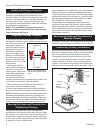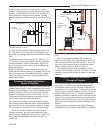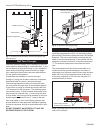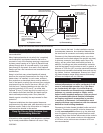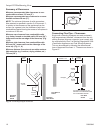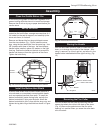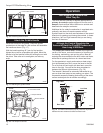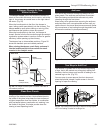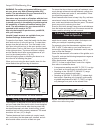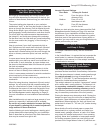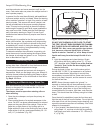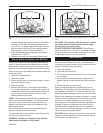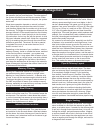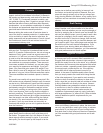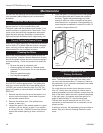
14
Intrepid II Woodburning Stove
30003840
WARNING: For safety and greatest efficiency, oper-
ate your stove only with all doors/griddles fully
closed. The test standard for your stove when it is
operated in this mode is UL 1482.
Your stove may be used as a fireplace with the front
doors open or removed only when the spark screen
is placed correctly in the opening to protect against
the possibility of sparks and embers leaving your
stove. The test standard for your stove when it is
operated in this mode is UL 737.
Use only the Intrepid II spark screen, part #0136,
with your Intrepid II.
Intrepid II spark screens are available from your
Vermont Castings’ Authorized Dealer.
To open the front doors, insert the handle into the door
latch stub and turn it to the left and up. To close them,
always close the left door first. Turn the handle in the
right door to the left and up (to the open position) and
close the door. Push on the door as you turn the handle
to the right and down. The doors will draw in slightly,
and the handle should offer some resistance as you
turn it to the closed position. (Fig. 23)
Avoid striking the glass or slamming the doors to re-
duce the risk of breaking the glass.
When you’re not using the door handle, store it in the
holder behind the right front leg of the stove.
ST522
Intrepid
close doors
11/00
Open
Position
Closed
Position
ST522
Fig. 23 To open the front doors, turn handle clockwise.
Burn Only High-Quality Wood
The Intrepid II is designed to burn natural wood only; do
not burn fuels other than that for which it was designed.
You’ll enjoy the best results when burning wood that
has been adequately air-dried. Avoid burning “green”
wood that has not been properly seasoned. The wood
should be 410 mm (16”) in length.
The best hardwood fuels include oak, maple, beech,
ash, and hickory that has been split, stacked, and air-
dried outside under cover for at least one year.
For areas that do not have a supply of hardwood, com-
monly burned softwoods include tamarack, yellow pine,
white pine, Eastern red cedar, fir, and redwood. These
too should be properly dried.
Store firewood under cover to keep it dry. Dry, well-sea
-
soned wood is best for heating and fire-viewing. How-
ever, avoid wood dried more than two years. This wood
burns very quickly, reducing burn time.
Even for short-term storage, keep wood a safe distance
from the heater and keep it out of the areas around the
heater used for refueling and ash removal.
A Surface Thermometer is a Valuable
Guide to Operation
An optional surface thermometer tells you when to
adjust the air control, when to refuel, and helps to tell
when your catalyst is operating properly.
For example, when the thermometer registers at least
230° C (450° F) after start-up you know the stove is
hot enough to begin catalytic combustion and it may be
time to close the damper.
Place the thermometer in the center of the griddle, as in
Figure 24, and use the following temperature ranges as
a guide to operation:
When thermometer readings drop below 175° C
(350° F) it’s time to adjust the air control for a higher
burn rate or to reload the stove.
• A temperature reading over 400° C (750° F) is a sign
to cut back on the air supply to slow the burn rate.
• Readings in the 150-200° C (300-400° F) range
indicate low to medium heat output.
• Readings of 260-340° C (500-650° F) indicate high
heat output. Operating your Intrepid II continuously
at griddle temperatures of 400° C (750°F) or higher
may damage inner parts or the enamel finish.
ST523
Intrepid
temp readings
11/00
ST523
Fig. 24 Take temperature readings with a thermometer lo-
cated in the middle of the griddle.



